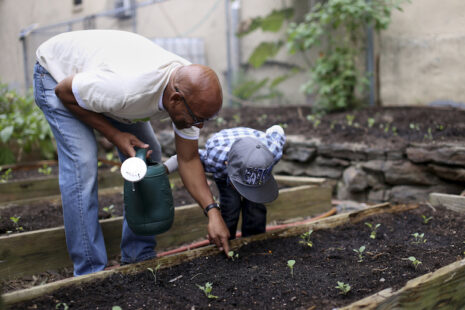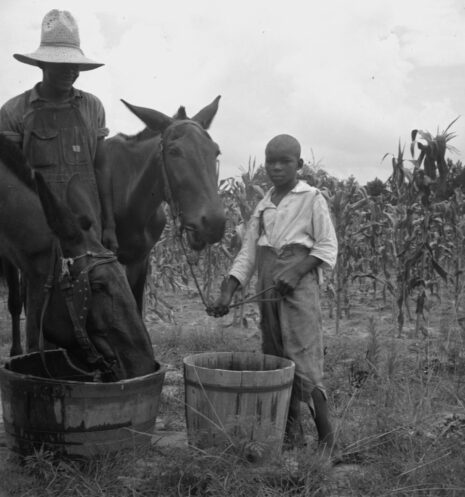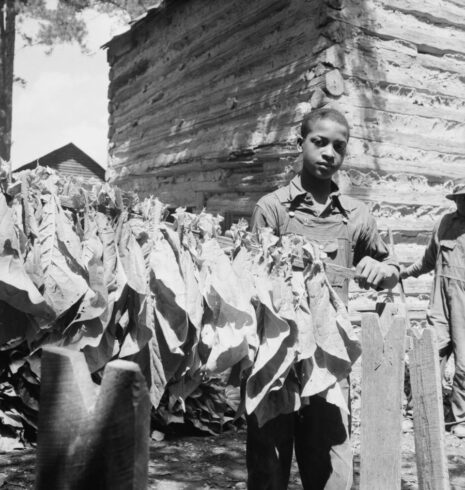
As we come to the end of another Black History Month in the US and Canada, it’s a great time to reflect on the enormous contributions that people of African descent have made in the realm of agriculture and farming. Since the colonial period, when so many Africans were forcibly brought to the Americas to provide slave labor, Black people have influenced and created innovative and highly successful farming techniques and practices, and introduced new foods- despite controlling less than 2% of the farmland in this country to this day.
While concepts such as sustainable agriculture and community farming may seem like recent developments, they are rooted in ancient land practices that Black and Indigenous farmers have been perfecting for centuries, and in many cases, we have BIPOC activists to thank for keeping those traditions alive and relevant in the present day.
 This photo, taken by Dorothea Lange for the Works Progress Administration in the 1930s, shows a man and his son watering their mules on their family farm, owned by the man’s father. While some of the Black farmers Lange photographed in this series shot in North Carolina were tenant farmers and sharecroppers, others owned their own farms and worked their own land.
This photo, taken by Dorothea Lange for the Works Progress Administration in the 1930s, shows a man and his son watering their mules on their family farm, owned by the man’s father. While some of the Black farmers Lange photographed in this series shot in North Carolina were tenant farmers and sharecroppers, others owned their own farms and worked their own land.
Here are some of the innovations that we can thank Black farmers and activists for introducing to our agriculture system:
 Community Land Trusts
Community Land Trusts
Since 1969, these nonprofit community-based organizations have focused on land stewardship and conservation, affordable housing, community gardens and other resources in low-income and majority Black communities. Charles and Shirley Sherrod established their New Communities farm and communal living space that year in Georgia, and soon established the 5,000+ acre farm as a safe haven for Black farmers from across the South. The vibrant community they created inspired others across the country and across the world, and today there are more than 225 community land trusts in the US, many of them in urban areas.
Community Supported Agriculture
Today, Community Supported Agriculture (CSA) programs may bring to mind farmer’s markets and the locavore food movement, and are often credited to farm programs started by white men in the mid 1980s. But the original ideas behind CSAs were first promoted by Booker T. Whatley, a Black horticulturalist and professor at Tuskegee University, in the 1960s. His firm belief in supporting small farms led him to create the first subscription model for shares of a farm;’s harvest, which helped farmers plan production and manage costs throughout the year, while guaranteeing a market for their produce. The model lives on as the basis for current CSA programs.
 Crop Rotation and Cover Crops
Crop Rotation and Cover Crops
One of the most famous names in Black history is George Washington Carver, an agricultural scientist and inventor who was also a professor at Tuskegee University. In that role, he made many critical discoveries that impacted agricultural systems. One of the most significant (and important to this day) was his work on soil depletion. Cotton monoculture farming in the South had depleted the soil and Carver was the first to suggest that rotating in nitrogen fixing crops like peanuts, sweet potatoes and soybeans could replenish the soil so that more cotton could be grown in subsequent seasons. He also advocated for planting clover as a cover crop that could help make soil more fertile, an idea that had been part of African farming practices but had largely been ignored as industrialization took over agriculture after World War II. These practices continue to be important in sustainable agriculture to this day.
Want to learn more about the sustainable land practices and food justice work of Black activists, scientists and farmers? Check out this article on the NYCFoodPolicy.org website here.


